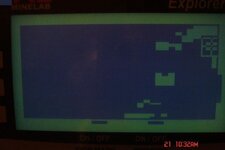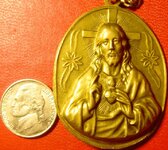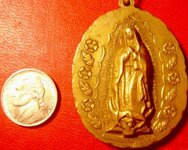tgravatt
Jr. Member
Hello!
(Just a note here; I will try to continually update these thoughts and ideas as time permitting)
I think that you are on the right track for the Minelabs. I got my first one in 2000. It was the Explorer XS. It does take some time and learning to get the machine to work better then I would have ever imagined.
In the Advanced mode, I take my collection of things that I care to find, (1 gold coin currently its a $2.50 Indian head, but I also sometimes use a $10 gold bullion coin, 1 Morgan dollar, 1 Eisenhower dollar, 1 walking liberty half, 1 barber quarter, 1 barber dime, 1 mercury dime- wouldn't want to miss that 1916D! -, 1 standing liberty quarter, 1 early Washington quarter, 1 early Indian head cent, 1 later Indian head cent-because of different metal in the mintage, 1 buffalo nickel, 1 V nickel (I bought one, later that afternoon, found my first one), 1 shield nickel-oldest found so far is 1866 w/rays-, 1 1909 Lincoln wheat cent, 3 different types of gold rings, wedding band 14K, 14K w/gold coin & diamonds, and 1 14K w/emeralds/diamonds, 2 different types of silver rings- 1 with turquoise, and another just a silver band, and finally, some gold 14K & silver religious medallions - people always seem to lose these- found three gold ones in one day in a park in OK City once, one nearly as large as an egg!).
Please bear in mind that even the much older silver, gold and other types of coins have not changed significantly since they began minting them as far as their particular valuable metal content, so these coins that I use also work well for those. For example, the early half-cents and cents are 100% copper and will trigger a signal, additionally, half dimes, seated dimes, 20-cent pieces, draped bust quarters, etc, all are at least 89% silver and would also trigger a signal as programmed with similar valuable metal content coins listed above. Gold coins are all at least 89% gold as well, and recently, I started using gold nuggets as well to add yet another white out block to the pre-programmed settings as indicated above. Not that I intend to find gold nuggets so much, most places you never will, but I think that people have done so many "creative" things with gold, you just never know what might be under the coil.
In the Advance mode, Learn mode, (be sure to turn the sensitivity down to around 16 or a bit lower before starting), black out the entire screen, then select the Check mark, USING THE MEDIUM BLOCK, start waving these items back and forth in front of the coil, (be sure and have no other metal anywhere near the coil), it may take several times, but you can see that a white area is blocked out from the black screen. Continue until all items have been blocked in "white", or background color, in the learn mode screen. Finish by pressing the Check mark again and then on the right, save the program to a location (one of 6 possible).
Then press the detect button and either use the digital screen or the smart screen, both have advantages, depending upon where/how you may be using the detector. When over a questionable target, I often switch back and forth from digital to the expanded smart screen, its quicker than digging more trash, but also helps to give you a better idea of just exactly what type of metal is under the coil. The expanded smart screen can sometimes show that the crosshairs jump around and do not stay stable in one particular area of the screen, while the digital screen may remain unchanged, or vice versa.
I have also done this same procedure using only the small block to learn, but have found that the edge trash still is unavoidable. For example, there is a certain type of pull-tab that has the exact same digital/smart values as does the Indian head cents, nickels and some types of pull-tabs are the same way. It is simply unavoidable. I dug up some pull tabs, taught the detector to not signal when detecting, but then quickly realized that it would not alert or signal when an Indian head was under the coil. This is especially true for gold rings. Some are exactly like screw caps, while others just like some pull-tabs.
I certainly do take the time after programming to document what each of the above items register in both the digital screen and the smart screen. I have found that it does make a difference on weeding out the tons of trash that are out there. For example, a mercury dime will register as a 3 (ferrous) & 29 (conductivity), and an Indian head cent will register 8 (ferrous) & 13 (conductivity).
At first, when detecting, be sure to set the detector on the ground and press the noise cancel button, without moving the detector, be sure there is no metal under the coil, let the noise cancel finish it's cycle, and then you are ready to start the real learning process. Even in fairly small parks, it?s a good idea to do the noise cancel every so often.
I start with the manual sensitivity at 21 and either work it up or down depending upon how much trash is in the area. You can tell trash because it mutes out the threshold tone. Quite often, it does become necessary to switch to the automatic sensitivity setting, by pressing the center pushbutton on the left side. When you are walking along, swinging and come to areas where the threshold tone stops because of the higher mineral content of the soil, switching to the automatic sensitivity mode restores the audible threshold tone. You can tell when you are in the automatic sensitivity mode, because there is a circulating line the moves around the value displayed for the sensitivity setting. Choosing this setting has helped me to find "keepers" even when the noise canceling process has minimal effect.
Also in the advance mode, I set the fast and deep settings, but swing at a slow to moderate speed. You sort of get used to a wide semi-circle medium speed swing that overlaps in area back and forth. It helps to allow the machine time to recover from trash signals to something good.
When ready and swinging, dig all signals at first, when finding trash- its nearly impossible to weed out or discriminate trash if you want to find the good stuff-, as each trash item is found, go back to the learn screen, select the "X" USING THE SMALL BLOCK, wave the trash item in front of the coil and teach it not to find this trash item. When finished, press the "X" button again and save this to either a new program number or the same as before. The first time I am at a new area, I take all the trash out; first of all, it helps clean the area so that I can go back and not be bothered by it, secondly, sometimes that trash is pure copper things, which sells at a scrap metal place for a tidy sum. Recently, I found about 5 pounds of raw aluminum ore-strangest thing, cannot imagine how aluminum ore got into this particular park, but there must be a reason for it-lol!
It is handy to keep the first learned medium block as is and keep modifying and saving in subsequent programs. For example, save the first learn in program 1, and then as you go along, create milestones when something works well, save it to program 2,3, etc. That way, if something goes wrong, you can sort of back up by reloading a previous program and start again.
If, after you have programmed your desired finds, and realize that there are areas that have been incorrectly blocked out from the black screen, you can use edit mode and small or medium block to black them in again. Sometimes when programming the good stuff, you will get small areas that are not blacked out but should be, due to the variation of waving the good stuff in front of the coil.
I have learned that some trash items, especially when deep in the ground, can trigger a good signal, and are right on the edge of the good stuff-metal property-wise that is, so with the small block, you can get past more of these trash items. You can also specialize programs, like say just for silver dimes, quarter, halves, and one program just for gold items or something like that.
I have in mine, program 1 is the first learned medium block out, and program 2 is the first learned small block out. Sometimes in very trashy areas, I switch to the small block program and continue with the learning and modifying as I go. (In the Advanced learn and edit mode, there are three block sizes, small, medium and large)
Just be sure that you check now and then to make sure that the programmed stuff still sets a good signal. You must continue this process until you have basically weeded out all the "edge" trash, as I call it, and then you will only find mostly the good stuff after that. Takes time, but brother its worth it!
Also, in either the digital screen or the smart screen, I have learned that when the numbers jump around, or the crosshairs move when swinging, usually its a trash item or as I have learned, multiple items, which the Explorer II does indicate with multiple tones in quick succession, listening acutely to what tones are there is a great help. I good target will normally stay solid in both the audible tone as well as the crosshair position in the smart screen and the digital number in the digital screen.
Also, when a good target is near trash, I often just keep circling the area, testing, listening, trash does often cover up good stuff, but keep circling and swinging. A short time ago, doing this, I found a 1906 Canadian quarter, with a nail, and a pull-tab in the same hole and many other things in the same way. I think that by circling a target, you get different angles on the object and this will also help to make the decision to dig, mostly, I dig.
I have developed what I call the "Yellow Brick Road" method to searching patterns. A simple and explainable example of such is this; say for instance you are walking along on "your" particular search pattern and you come across something like a coin, you dig it, find it, put it in your pouch. Ok. What?s next? For me, that coin is the epi-center of an event that caused that coin to be there in the first place. So I start from that very point that the coin was found and start swinging in overlapping, and ever-widening circle around that very spot. Just like the beginning of the "Yellow Brick Road" in the Wizard of Oz movie.
Most people that metal detect, often walk in a straight line, which I do as well, but when I find something I circle in ever-widening, overlapping sweeps just to be sure that that particular area is well covered, then I continue on with my straight "SAR" (search and rescue) - grid-like pattern as usual. Try to think of that as like mowing a yard, you can then imagine where you have been and where you are going with the pattern. It isn?t hard to imagine that if one coin was lost, that others are likely to be in that same area.
Old rusted steel and alloys corroded, are a trick, since they can trigger a false reading which is similar to something solid silver, which had me stumped for a bit, since it was an old rusty piece of wire, but not far underneath was the forget-me-not silver bracelet in the pics here. Just remember that the solid signal, unchanging, not bouncing is the key here, but I have found old silver coins and good stuff right in there with the heavily rusted stuff.
One thing for sure that I really like about the Explorers, is that there is a different pitch in tone for different signals. Now, without a doubt, I can pretty much tell exactly what is in the ground just by the tone.
One of the sweetest sounds is the tone for Mercury/Barber/Seated dimes. It is un-mistakable with the Explorer II. I can always tell now when one of these is under the coil. Of course to a person that may be tone deaf, not a good thing, but like everything else in life, if you are interested enough, you will get past your own personal barriers and simply learn the range of tones.
Of course, if you use the factory pre-sets, and are in an area with a lot of trash, you will get all kinds of signals, that is why it is so critical to get into the Advance mode and fine tune yourself and the detector. That is the key, fine-tune yourself and the detector.
Another thing about the Explorers is that with the rechargeable battery, I can swing for a long time, usually get wore out digging before the battery gets too low, but I also have two back-ups and the car charger as well.
I don't think they are heavy, to swing at all. I hardly feel the weight of mine at all now. And with the right length setup, they seem to balance well.
The depth that these detectors can go is amazing. When I first started with the XS, I found a lid for a 50 gallon drum about 5 feet deep (my girlfriends yard, she was kind of wondering just how far I was going to dig. I also found a 1916 S mercury dime and some old dairy tokens, 1 Indian head (1863), a 1914D Barber dime (both the mercury and the Barber looked as though they just came from the mint), and a few early wheat pennies, one was a 1909 plain.
Later, as I got better at it, I found a walking liberty half at about 18 inches. Lately, it isn't unusual to find coins a foot or better deep. I once found a silver religious medallion, which was pretty small nearly 14 inches deep. Using the headphones really helps to hear the faint signals.
I also boosted the gain to +7, which helps to bring in the faintest of signals.
Its always a learning process, every time out, but I can tell you for sure, its fun, and some of the things I have found completely amaze me!
Now, I dig everything. Couple of weeks ago, found a Pope XIII Leo Silver medallion, big as a silver dollar, which is from the 1880?s according to Mark Parker, in a supposedly hunted out park!
Yes, you can spend less for a metal detector ( The first XS was around $1,100, the Explorer XS's sell for around $500 now, the second Explorer II,I got off of eBay for $900- I think the guy couldn't deal with the advanced stuff- and the last one, just a couple of weeks ago, another Explorer II, from a dealer for around $1,135), but certainly, with a cheaper detector, most people get frustrated by digging trash all the time and end up using it for a coat rack or something.
I say spend as much as you can possibly afford, get the best, and in a short time, you will be digging up some real treasures, and thus ensuring a great detecting experience.
Here is a thought. When Minelab comes up with a detector that I can connect to my computer and really, deeply analyze, modify, and save learned programs, I'll be happier. After all, my camera does it. My cell phones do it. My music equipment does it. My digital multi-meter does it. Why not my metal detector? If it comes with a USB plug it is exploitable.
Take care,
And Happy Hunting!
T.G. Creations
Explorer XS, 2, Explorer II's, Gold Bug II, New Garret Ace 250, 1 old radio shack detector, 2 bounty hunters, 1 Garrett GTAX, and 1 older Garrett treasure ACE 150. (Saving up for the Minelab GP 3500)
(Just a note here; I will try to continually update these thoughts and ideas as time permitting)
I think that you are on the right track for the Minelabs. I got my first one in 2000. It was the Explorer XS. It does take some time and learning to get the machine to work better then I would have ever imagined.
In the Advanced mode, I take my collection of things that I care to find, (1 gold coin currently its a $2.50 Indian head, but I also sometimes use a $10 gold bullion coin, 1 Morgan dollar, 1 Eisenhower dollar, 1 walking liberty half, 1 barber quarter, 1 barber dime, 1 mercury dime- wouldn't want to miss that 1916D! -, 1 standing liberty quarter, 1 early Washington quarter, 1 early Indian head cent, 1 later Indian head cent-because of different metal in the mintage, 1 buffalo nickel, 1 V nickel (I bought one, later that afternoon, found my first one), 1 shield nickel-oldest found so far is 1866 w/rays-, 1 1909 Lincoln wheat cent, 3 different types of gold rings, wedding band 14K, 14K w/gold coin & diamonds, and 1 14K w/emeralds/diamonds, 2 different types of silver rings- 1 with turquoise, and another just a silver band, and finally, some gold 14K & silver religious medallions - people always seem to lose these- found three gold ones in one day in a park in OK City once, one nearly as large as an egg!).
Please bear in mind that even the much older silver, gold and other types of coins have not changed significantly since they began minting them as far as their particular valuable metal content, so these coins that I use also work well for those. For example, the early half-cents and cents are 100% copper and will trigger a signal, additionally, half dimes, seated dimes, 20-cent pieces, draped bust quarters, etc, all are at least 89% silver and would also trigger a signal as programmed with similar valuable metal content coins listed above. Gold coins are all at least 89% gold as well, and recently, I started using gold nuggets as well to add yet another white out block to the pre-programmed settings as indicated above. Not that I intend to find gold nuggets so much, most places you never will, but I think that people have done so many "creative" things with gold, you just never know what might be under the coil.
In the Advance mode, Learn mode, (be sure to turn the sensitivity down to around 16 or a bit lower before starting), black out the entire screen, then select the Check mark, USING THE MEDIUM BLOCK, start waving these items back and forth in front of the coil, (be sure and have no other metal anywhere near the coil), it may take several times, but you can see that a white area is blocked out from the black screen. Continue until all items have been blocked in "white", or background color, in the learn mode screen. Finish by pressing the Check mark again and then on the right, save the program to a location (one of 6 possible).
Then press the detect button and either use the digital screen or the smart screen, both have advantages, depending upon where/how you may be using the detector. When over a questionable target, I often switch back and forth from digital to the expanded smart screen, its quicker than digging more trash, but also helps to give you a better idea of just exactly what type of metal is under the coil. The expanded smart screen can sometimes show that the crosshairs jump around and do not stay stable in one particular area of the screen, while the digital screen may remain unchanged, or vice versa.
I have also done this same procedure using only the small block to learn, but have found that the edge trash still is unavoidable. For example, there is a certain type of pull-tab that has the exact same digital/smart values as does the Indian head cents, nickels and some types of pull-tabs are the same way. It is simply unavoidable. I dug up some pull tabs, taught the detector to not signal when detecting, but then quickly realized that it would not alert or signal when an Indian head was under the coil. This is especially true for gold rings. Some are exactly like screw caps, while others just like some pull-tabs.
I certainly do take the time after programming to document what each of the above items register in both the digital screen and the smart screen. I have found that it does make a difference on weeding out the tons of trash that are out there. For example, a mercury dime will register as a 3 (ferrous) & 29 (conductivity), and an Indian head cent will register 8 (ferrous) & 13 (conductivity).
At first, when detecting, be sure to set the detector on the ground and press the noise cancel button, without moving the detector, be sure there is no metal under the coil, let the noise cancel finish it's cycle, and then you are ready to start the real learning process. Even in fairly small parks, it?s a good idea to do the noise cancel every so often.
I start with the manual sensitivity at 21 and either work it up or down depending upon how much trash is in the area. You can tell trash because it mutes out the threshold tone. Quite often, it does become necessary to switch to the automatic sensitivity setting, by pressing the center pushbutton on the left side. When you are walking along, swinging and come to areas where the threshold tone stops because of the higher mineral content of the soil, switching to the automatic sensitivity mode restores the audible threshold tone. You can tell when you are in the automatic sensitivity mode, because there is a circulating line the moves around the value displayed for the sensitivity setting. Choosing this setting has helped me to find "keepers" even when the noise canceling process has minimal effect.
Also in the advance mode, I set the fast and deep settings, but swing at a slow to moderate speed. You sort of get used to a wide semi-circle medium speed swing that overlaps in area back and forth. It helps to allow the machine time to recover from trash signals to something good.
When ready and swinging, dig all signals at first, when finding trash- its nearly impossible to weed out or discriminate trash if you want to find the good stuff-, as each trash item is found, go back to the learn screen, select the "X" USING THE SMALL BLOCK, wave the trash item in front of the coil and teach it not to find this trash item. When finished, press the "X" button again and save this to either a new program number or the same as before. The first time I am at a new area, I take all the trash out; first of all, it helps clean the area so that I can go back and not be bothered by it, secondly, sometimes that trash is pure copper things, which sells at a scrap metal place for a tidy sum. Recently, I found about 5 pounds of raw aluminum ore-strangest thing, cannot imagine how aluminum ore got into this particular park, but there must be a reason for it-lol!
It is handy to keep the first learned medium block as is and keep modifying and saving in subsequent programs. For example, save the first learn in program 1, and then as you go along, create milestones when something works well, save it to program 2,3, etc. That way, if something goes wrong, you can sort of back up by reloading a previous program and start again.
If, after you have programmed your desired finds, and realize that there are areas that have been incorrectly blocked out from the black screen, you can use edit mode and small or medium block to black them in again. Sometimes when programming the good stuff, you will get small areas that are not blacked out but should be, due to the variation of waving the good stuff in front of the coil.
I have learned that some trash items, especially when deep in the ground, can trigger a good signal, and are right on the edge of the good stuff-metal property-wise that is, so with the small block, you can get past more of these trash items. You can also specialize programs, like say just for silver dimes, quarter, halves, and one program just for gold items or something like that.
I have in mine, program 1 is the first learned medium block out, and program 2 is the first learned small block out. Sometimes in very trashy areas, I switch to the small block program and continue with the learning and modifying as I go. (In the Advanced learn and edit mode, there are three block sizes, small, medium and large)
Just be sure that you check now and then to make sure that the programmed stuff still sets a good signal. You must continue this process until you have basically weeded out all the "edge" trash, as I call it, and then you will only find mostly the good stuff after that. Takes time, but brother its worth it!
Also, in either the digital screen or the smart screen, I have learned that when the numbers jump around, or the crosshairs move when swinging, usually its a trash item or as I have learned, multiple items, which the Explorer II does indicate with multiple tones in quick succession, listening acutely to what tones are there is a great help. I good target will normally stay solid in both the audible tone as well as the crosshair position in the smart screen and the digital number in the digital screen.
Also, when a good target is near trash, I often just keep circling the area, testing, listening, trash does often cover up good stuff, but keep circling and swinging. A short time ago, doing this, I found a 1906 Canadian quarter, with a nail, and a pull-tab in the same hole and many other things in the same way. I think that by circling a target, you get different angles on the object and this will also help to make the decision to dig, mostly, I dig.
I have developed what I call the "Yellow Brick Road" method to searching patterns. A simple and explainable example of such is this; say for instance you are walking along on "your" particular search pattern and you come across something like a coin, you dig it, find it, put it in your pouch. Ok. What?s next? For me, that coin is the epi-center of an event that caused that coin to be there in the first place. So I start from that very point that the coin was found and start swinging in overlapping, and ever-widening circle around that very spot. Just like the beginning of the "Yellow Brick Road" in the Wizard of Oz movie.
Most people that metal detect, often walk in a straight line, which I do as well, but when I find something I circle in ever-widening, overlapping sweeps just to be sure that that particular area is well covered, then I continue on with my straight "SAR" (search and rescue) - grid-like pattern as usual. Try to think of that as like mowing a yard, you can then imagine where you have been and where you are going with the pattern. It isn?t hard to imagine that if one coin was lost, that others are likely to be in that same area.
Old rusted steel and alloys corroded, are a trick, since they can trigger a false reading which is similar to something solid silver, which had me stumped for a bit, since it was an old rusty piece of wire, but not far underneath was the forget-me-not silver bracelet in the pics here. Just remember that the solid signal, unchanging, not bouncing is the key here, but I have found old silver coins and good stuff right in there with the heavily rusted stuff.
One thing for sure that I really like about the Explorers, is that there is a different pitch in tone for different signals. Now, without a doubt, I can pretty much tell exactly what is in the ground just by the tone.
One of the sweetest sounds is the tone for Mercury/Barber/Seated dimes. It is un-mistakable with the Explorer II. I can always tell now when one of these is under the coil. Of course to a person that may be tone deaf, not a good thing, but like everything else in life, if you are interested enough, you will get past your own personal barriers and simply learn the range of tones.
Of course, if you use the factory pre-sets, and are in an area with a lot of trash, you will get all kinds of signals, that is why it is so critical to get into the Advance mode and fine tune yourself and the detector. That is the key, fine-tune yourself and the detector.
Another thing about the Explorers is that with the rechargeable battery, I can swing for a long time, usually get wore out digging before the battery gets too low, but I also have two back-ups and the car charger as well.
I don't think they are heavy, to swing at all. I hardly feel the weight of mine at all now. And with the right length setup, they seem to balance well.
The depth that these detectors can go is amazing. When I first started with the XS, I found a lid for a 50 gallon drum about 5 feet deep (my girlfriends yard, she was kind of wondering just how far I was going to dig. I also found a 1916 S mercury dime and some old dairy tokens, 1 Indian head (1863), a 1914D Barber dime (both the mercury and the Barber looked as though they just came from the mint), and a few early wheat pennies, one was a 1909 plain.
Later, as I got better at it, I found a walking liberty half at about 18 inches. Lately, it isn't unusual to find coins a foot or better deep. I once found a silver religious medallion, which was pretty small nearly 14 inches deep. Using the headphones really helps to hear the faint signals.
I also boosted the gain to +7, which helps to bring in the faintest of signals.
Its always a learning process, every time out, but I can tell you for sure, its fun, and some of the things I have found completely amaze me!
Now, I dig everything. Couple of weeks ago, found a Pope XIII Leo Silver medallion, big as a silver dollar, which is from the 1880?s according to Mark Parker, in a supposedly hunted out park!
Yes, you can spend less for a metal detector ( The first XS was around $1,100, the Explorer XS's sell for around $500 now, the second Explorer II,I got off of eBay for $900- I think the guy couldn't deal with the advanced stuff- and the last one, just a couple of weeks ago, another Explorer II, from a dealer for around $1,135), but certainly, with a cheaper detector, most people get frustrated by digging trash all the time and end up using it for a coat rack or something.
I say spend as much as you can possibly afford, get the best, and in a short time, you will be digging up some real treasures, and thus ensuring a great detecting experience.
Here is a thought. When Minelab comes up with a detector that I can connect to my computer and really, deeply analyze, modify, and save learned programs, I'll be happier. After all, my camera does it. My cell phones do it. My music equipment does it. My digital multi-meter does it. Why not my metal detector? If it comes with a USB plug it is exploitable.
Take care,
And Happy Hunting!
T.G. Creations
Explorer XS, 2, Explorer II's, Gold Bug II, New Garret Ace 250, 1 old radio shack detector, 2 bounty hunters, 1 Garrett GTAX, and 1 older Garrett treasure ACE 150. (Saving up for the Minelab GP 3500)
Attachments
-
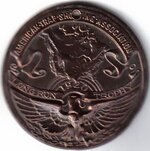 American Trapshooting Association Medel OBV.jpg35.1 KB · Views: 803
American Trapshooting Association Medel OBV.jpg35.1 KB · Views: 803 -
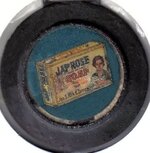 Jap Rose Soap OBV.jpg34.6 KB · Views: 784
Jap Rose Soap OBV.jpg34.6 KB · Views: 784 -
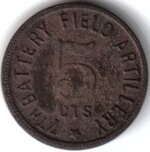 7th Battery Field Artillery 5 cts OBV.jpg12.6 KB · Views: 756
7th Battery Field Artillery 5 cts OBV.jpg12.6 KB · Views: 756 -
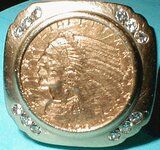 PC290008.JPG79.6 KB · Views: 773
PC290008.JPG79.6 KB · Views: 773 -
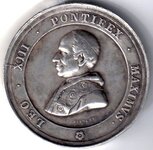 Pope Leo XIII OBV.jpg47.3 KB · Views: 774
Pope Leo XIII OBV.jpg47.3 KB · Views: 774 -
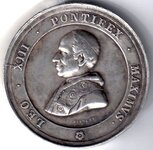 Pope Leo XIII OBV.jpg47.3 KB · Views: 767
Pope Leo XIII OBV.jpg47.3 KB · Views: 767 -
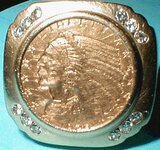 PC290008.JPG79.6 KB · Views: 756
PC290008.JPG79.6 KB · Views: 756 -
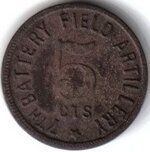 7th Battery Field Artillery 5 cts OBV.jpg12.6 KB · Views: 751
7th Battery Field Artillery 5 cts OBV.jpg12.6 KB · Views: 751 -
 Silver Bracelets.JPG70.3 KB · Views: 784
Silver Bracelets.JPG70.3 KB · Views: 784 -
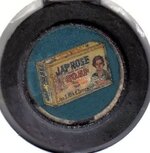 Jap Rose Soap OBV.jpg34.6 KB · Views: 781
Jap Rose Soap OBV.jpg34.6 KB · Views: 781 -
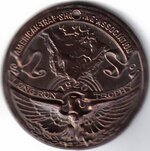 American Trapshooting Association Medel OBV.jpg35.1 KB · Views: 799
American Trapshooting Association Medel OBV.jpg35.1 KB · Views: 799
Upvote
0




 Really nice finds. HH
Really nice finds. HH